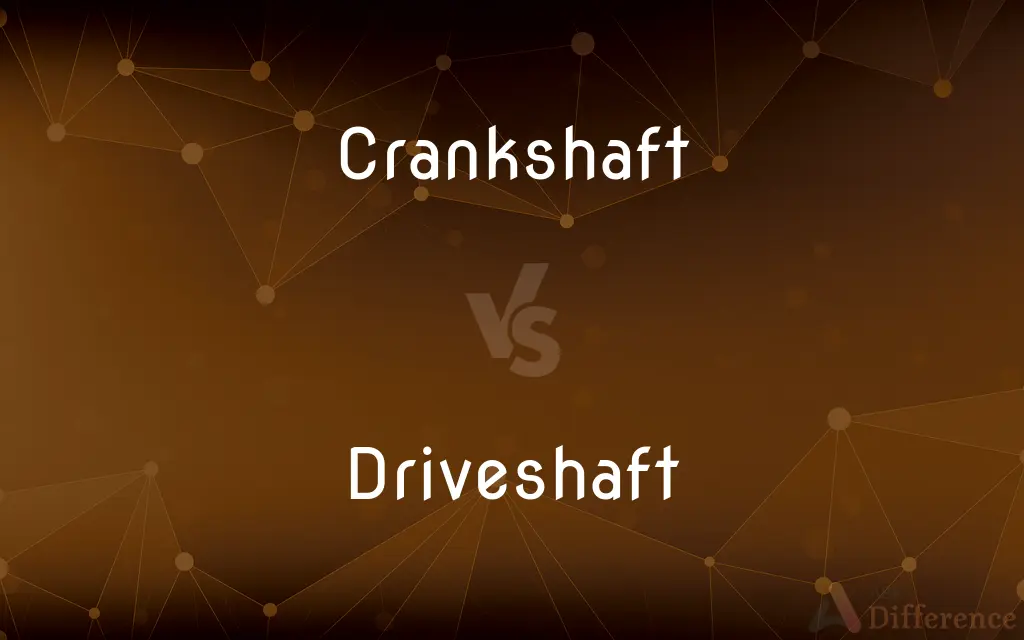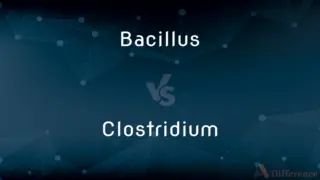Crankshaft vs. Driveshaft — What's the Difference?
By Maham Liaqat & Fiza Rafique — Updated on March 28, 2024
A crankshaft converts the reciprocating motion of pistons into rotational motion within an engine, while a driveshaft transfers rotational motion from the engine to the wheels or other parts of a vehicle's drivetrain.

Difference Between Crankshaft and Driveshaft
Table of Contents
ADVERTISEMENT
Key Differences
The crankshaft is a fundamental component of an engine's internal combustion system. It resides within the engine block and is directly connected to pistons via connecting rods. As the pistons move up and down due to fuel combustion, the crankshaft translates this linear motion into rotational motion. This conversion is crucial for powering the vehicle, as rotational motion is what ultimately drives the wheels. In contrast, the driveshaft is a component of a vehicle's drivetrain, responsible for conveying rotational energy from the engine (or transmission) to other parts of the drivetrain, such as the differential in rear-wheel drive vehicles, which then powers the wheels.
The crankshaft's design, with its series of offset journals and counterweights, is engineered to optimize this conversion process and ensure smooth operation. Driveshafts must be both strong and lightweight, often made from materials like steel or aluminum, to efficiently transmit power without adding undue weight. They also accommodate for changes in length or angle due to vehicle suspension movement, often incorporating universal joints, slip joints, or both to maintain constant rotational velocity.
While the crankshaft operates within the confines of the engine, converting piston motion to rotational force, the driveshaft serves as a critical link in the chain of power transmission, extending that rotational force to the wheels or other components. Both are integral to vehicle operation, but they function at different stages of the power transmission process.
Understanding the roles and mechanical principles of both the crankshaft and the driveshaft is essential for comprehending how power is generated and transmitted in a vehicle. Their efficiency, durability, and design are key factors in the overall performance and reliability of the vehicle's drivetrain system.
Comparison Chart
Primary Function
Converts reciprocating motion to rotational motion
Transfers rotational motion to the drivetrain
ADVERTISEMENT
Location
Inside the engine block
Extends from the transmission to the differential (in RWD vehicles)
Connection
Connected to pistons via connecting rods
Connects transmission to wheels or other drivetrain components
Motion Source
Reciprocating motion of pistons due to combustion
Rotational motion from the engine or transmission
Material
Typically made of forged steel or cast iron
Often made from steel, aluminum, or carbon fiber
Key Features
Offset journals and counterweights for balance
Universal joints, slip joints for flexibility
Operation Context
Operates within the engine, driven by fuel combustion
Operates within the drivetrain, affected by vehicle dynamics
Compare with Definitions
Crankshaft
A crankshaft converts linear piston motion into rotational motion.
The engine's crankshaft ensures efficient power delivery to the drivetrain.
Driveshaft
Connects the transmission to the differential in RWD vehicles.
A vibrating driveshaft can indicate a need for alignment or repair.
Crankshaft
Essential for engine operation, residing within the engine block.
A damaged crankshaft can significantly impair an engine's performance.
Driveshaft
Often constructed from materials like aluminum for efficiency.
Lightweight driveshafts contribute to better fuel economy and performance.
Crankshaft
Made from durable materials like forged steel.
High-performance engines often feature crankshafts made of advanced alloys for strength.
Driveshaft
A driveshaft transfers rotational motion from the engine to the wheels.
The driveshaft's integrity is crucial for vehicle mobility.
Crankshaft
Designed with journals and counterweights for balance.
The crankshaft's design minimizes vibration, enhancing engine smoothness.
Driveshaft
Incorporates joints for flexibility and movement.
The universal joints on the driveshaft allow for a range of motion.
Crankshaft
A crankshaft is a shaft driven by a crank mechanism, consisting of a series of cranks and crankpins to which the connecting rods of an engine is attached. It is a mechanical part able to perform a conversion between reciprocating motion and rotational motion.
Driveshaft
A rotating shaft that transmits mechanical power from a motor or an engine to a point or region of application.
Crankshaft
A shaft that turns or is turned by a crank.
Driveshaft
A shaft used to transmit rotary motion.
Crankshaft
A rotating shaft that drives (or is driven by) a crank.
Driveshaft
A rotating shaft that transmits power from the engine to the point of application.
Crankshaft
(of a straight bolt or rod) To deform in such a manner that part of the rod or bolt is displaced sideways, offset from the longitudinal axis of the part, but remains parallel with the part's main longitudinal axis, with the final shape somewhat resembling a crankshaft.
Driveshaft
A rotating shaft that transmits power from the engine to the point of application
Crankshaft
A rotating shaft driven by (or driving) a crank
Common Curiosities
How do crankshafts and driveshafts differ in maintenance?
Crankshafts require minimal maintenance, often lasting the engine's lifespan, while driveshafts may need regular checks for alignment, balance, and joint integrity.
What happens if the driveshaft fails?
A failed driveshaft can lead to a complete loss of power transmission to the wheels, immobilizing the vehicle.
Are crankshafts and driveshafts interchangeable between vehicles?
No, they are designed specifically for each vehicle model, considering factors like engine power, vehicle size, and drivetrain layout.
How does the design of a crankshaft affect engine performance?
The crankshaft's design influences engine balance, power output, and vibration levels, impacting overall performance and durability.
How do modifications to the crankshaft or driveshaft affect a vehicle?
Modifications can improve performance but must be done carefully to maintain balance and integrity of the vehicle's drivetrain system.
What connects the crankshaft to the driveshaft?
The transmission (or gearbox) serves as the intermediary, converting the engine's rotational motion to a suitable form for the driveshaft.
Can a vehicle operate without a crankshaft or driveshaft?
No, both are essential; the crankshaft is crucial for converting combustion into motion, and the driveshaft is needed to transfer that motion to the wheels.
What advancements have been made in crankshaft and driveshaft technology?
Advances include materials like carbon fiber for driveshafts for reduced weight and increased strength, and improved alloys and manufacturing techniques for crankshafts to enhance performance and durability.
Can driveshafts affect vehicle handling?
Yes, the driveshaft's condition and design can influence vehicle dynamics, especially in terms of vibration and rotational balance.
Do all vehicles have driveshafts?
Most vehicles with internal combustion engines and traditional drivetrains have driveshafts, but configurations can vary, such as in front-wheel drive vehicles where the term might not be used in the same context.
Share Your Discovery

Previous Comparison
Kraken vs. Ship
Next Comparison
Bacillus vs. ClostridiumAuthor Spotlight
Written by
Maham LiaqatCo-written by
Fiza RafiqueFiza Rafique is a skilled content writer at AskDifference.com, where she meticulously refines and enhances written pieces. Drawing from her vast editorial expertise, Fiza ensures clarity, accuracy, and precision in every article. Passionate about language, she continually seeks to elevate the quality of content for readers worldwide.
















































